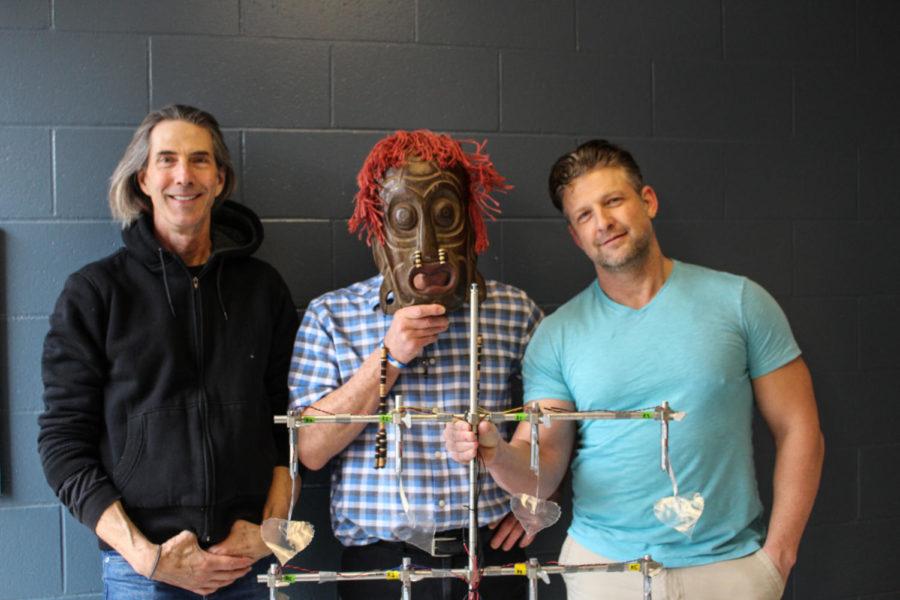- App Content
- App Content / News
- News
- News / Politics And Administration
- News / Politics And Administration / Campus
ElectriciTrees: Alternative energy research by Iowa State scientists
Dr. Eric Henderson (left), Dr. Michael McCloskey (middle), and Dr. Curtis Mosher (right) finish their piezoelectric, electricity generating, cottonwood tree prototype.
February 8, 2017
Imagine plugging a cellphone into a tree-powered outlet.
Three Iowa State scientists, Michael McCloskey, Eric Henderson and Curtis Mosher, said an idea like this is not impossible, merely in need of further development.
The three Iowa State scientists described the energy potential of a revamped concept of wind energy, energy through leaf movement by wind, in a peer-reviewed academic journal called PLOS ONE.
The study, funded by a National Science Foundation, is titled “Wind Energy Conversion by Plant-Inspired Designs.”
The project examines measurements of energy conversion through the use of a prototype that the team created using biomimetic principles, mimicking the device’s structure to the structure of a cottonwood tree.
The idea to test the ability of wind to create energy through leaf movement, though not new in the realm of science, originated from a moment of inspiration that Henderson, professor of genetics, development and cell biology, had years ago when he was looking out a window at leaves fluttering in the wind.
“On the phone, Eric sprung me the idea several years ago, said McCloskey, head of the scientific investigation on the project and professor of membrane biophysics and neurophysiology. “What if we could take trees and basically use the leaf energy, motion in the wind, to transduce that into electricity? Before too long I thought, this is an interesting challenge.”
The piezoelectric effect, or piezo effects, that the team used to harness leaf energy, are processes that convert mechanical energy into electrical energy through the use of certain materials like quartz.
The team applied the piezo effect in the study through the use of a specialized plastic that works within each of the prototypes’ leaves, according to the study.
One way the team improved upon previous attempts by other scientists to harness leaf energy as electrical energy through the piezoelectric effect was through its use of biomimetics.
The team’s prototype mimicked leaf movement in natural wind, a variable that was previously excluded in previously published leaf electricity experiments that took place in tunnels.
The refinement of the piezoelectric effect in the study, in its conclusion, shows that it is possible to improve energy harnessing through the mechanical movement of leaves.
Despite improving on this method of mechanical-to-electrical energy, the technology still cannot power a battery today.
Regardless of this fact, under further development, the technology is believed by the team to be a possible starting point for future off-grid sources of energy that could potentially power household appliances, Henderson said.
Some restrictions of the piezoelectric method and mechanical-to-electrical technology are issues with charge generation, transportation and storage methods, McCloskey said.
These issues require further research.
“The good news is we know what the problems are, and there are emerging technologies that probably can overcome some of [these] technological barriers.” Henderson said.
Despite the challenge of the project, Mosher, Carver Lab manager of Iowa State’s Molecular Printing Facility, believes the technology could progress as a marketable product if given the resources it needs.
“Even though people say it’s not about money, it is,” Henderson said. “Money is just another source of energy. If people take a huge amount of energy and inject it into a project like this, that’s money well spent, especially from a sustainability standpoint.”
If the technology is given the funds it needs to grow into a more efficient energy source, Henderson, Mosher and McCloskey believe that the product could provide a great clean source of energy that could contribute toward the United States, meeting the U.S. Department of Energy’s 2008 goal of having 20 percent wind energy by 2030.
Another benefit of the approach is it would be less “noisy and unattractive” compared to wind turbines.
“If you want technology to advance, you have to invest and do things,” Mosher siad. “If you want to stick with the status quo, that’s pretty easy, but don’t expect any advancement. You have to think of new designs […] and why invent the wheel when nature has already done a lot of that for us already? Mosher said.
If the team is given the funding to continue its research to test the ElectriciTree model, it would try using alternative mechanical-to-electrical conversion schemes such as triboelectricity.
It would also pursue a synthetic biology model with a naturally occurring peptide that surpasses the piezoelectric sensitivity of the plastic used in its previous study by 100,000 fold, McCloskey said.
















